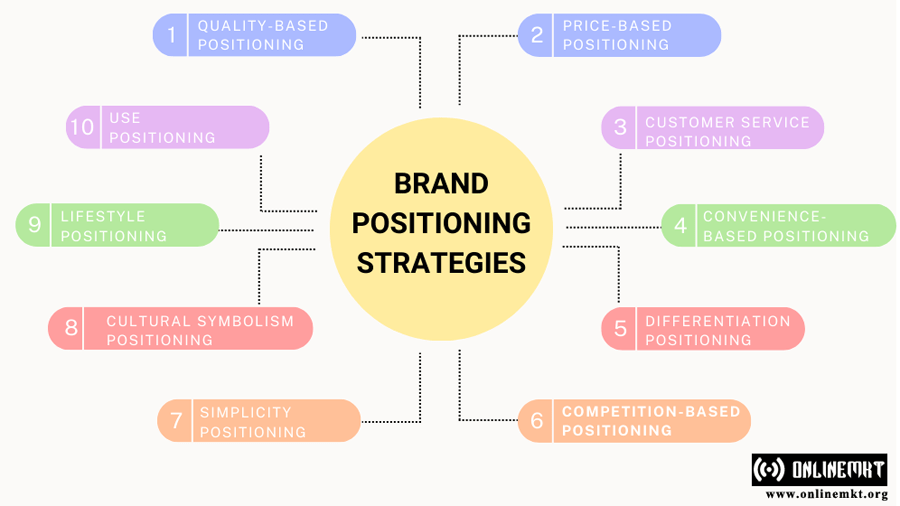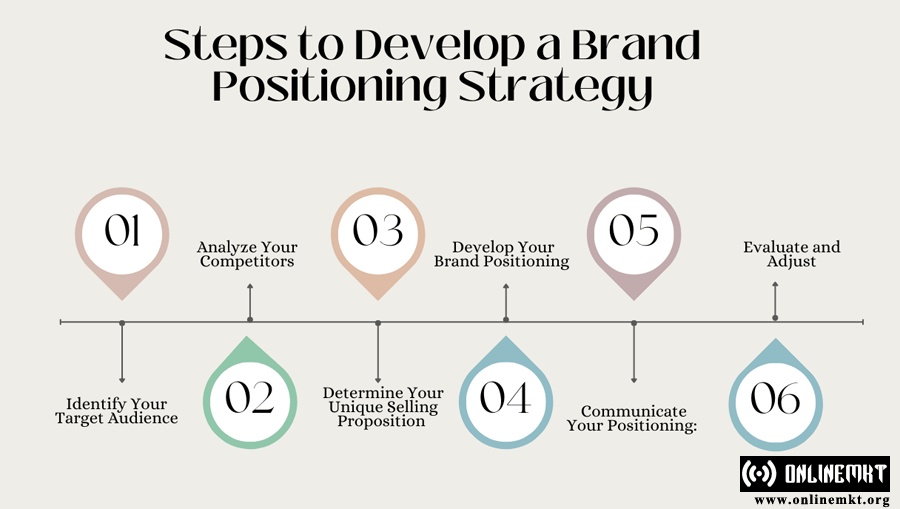Brand Positioning

Why do some brands become household names while others fade into obscurity? The answer is all about positioning.
From Apple to Nike, every most successful brand has one commonality: they are all masters of positioning.
Brand positioning is the secret to establishing a unique niche in your customers’ minds. Being different is not enough; you have to be memorable and irreplaceable. Successful brand positioning enables you to state your brand’s unique value in a few words and in an engaging manner, such that when customers consider a product category, they consider you first.
Brand positioning is the act of establishing a strong and positive impression of your brand in the minds of your audience. It is what sets your brand apart, playing your unique value proposition, and establishing your brand as the preferred option within your market.
When executed correctly, brand positioning can be the catalyst for explosive growth, turning your business into a market leader that dominates the industry. In this article, we will discuss the key strategies to get your brand positioning spot on and propel your business to new levels.
Brand Positioning Strategies
Quality-Based Positioning
This approach positions the brand as a representation of excellence and premium quality. It focuses on enhanced craftsmanship, higher quality materials, and better performance to appeal to customers who are concerned about high-quality products and are ready to pay extra for more value and pleasure.
Price-Based Positioning
With this strategy, the brand is positioned as the low-price industry player. It attracts price-sensitive buyers by highlighting low prices, promotions, and low-cost goods with a view to targeting this buyer clientele.
Customer Service Positioning
This positioning strategy focus on providing superior customer care and support. The mission is to be known for first-rate care and support, creating strong customer relations and loyalty. By constantly fulfilling and surpassing customer expectations and providing personalized service, the brand seeks to make itself stand out in a crowded marketplace.
Convenience-Based Positioning
On a convenience-based strategy, the brand is positioned most accessible to the consumer. It entails offering convenient buying options, quick delivery, easy returns, and simple-to-use interfaces. The aim is to target busy consumers who desire convenience and ease of buying.
Differentiation Positioning
It relies on the distinct qualities of the brand and innovativeness. It highlights the distinction the product or service provides, the distinct advantages, and solutions presented to the target clients. It is best applied with new or innovative brands with particular customer requirements.
Competition-Based Positioning
This technique entails the direct comparison of the brand with a competitor. It emphasizes the major differences that distinguish the product or service from others in the marketplace. This method can clearly differentiate the brand from rivals and leave a positive impression on consumers.
Simplicity Positioning
A simple, direct message will stay with consumers and stick longer. At times the most literal message is valuable. By using these techniques, brands are able to distinguish themselves, convey their unique value, and connect with customers on a deeper level. This practice translates to success and encourages loyalty in the competitive market.
Cultural Symbolism Positioning
Identifies the brand with cultural symbols or values to which the target market relates at an emotional level. This strategy extends beyond functional values to tap into the cultural context in which consumers learn about and imbue meaning in products or services. Brands using Cultural Symbolism Positioning frequently strive to position themselves as part of a grander cultural narrative, reaffirming identity, values, and aspirations to which their target market relates or aspires.
Lifestyle Positioning
Identifies the brand with a specific lifestyle or way of living, targeting customers who aspire to attain that lifestyle. Effective Lifestyle positioning is usually a matter of depicting the brand not merely as a goods supplier but rather as a facilitator of the desired lifestyle. By either evoking adventure, luxury, eco-friendliness, or wellbeing, brands try to appeal to customers who fancy these lifestyle desire.
Use Positioning
Emphasizes the particular use or application of the product, and illustrates how it can be applied in described situations or to execute particular tasks. It entails product, service, and promotional customization to meet these special requirements and expectations of such consumers. This approach goes beyond demographic segmentation to address such psychographic characteristics as attitude, beliefs, and lifestyles that affect purchasing behavior.
Steps to Develop a Brand Positioning Strategy

Identify Your Target Audience
Become familiar with your customers, their demographics, preferences, and behaviors. Have more than one target audience segment that is potential, rather than one audience. Recognize that brands will also have other groups of stakeholders that are not necessarily customers but remain relevant.
Analyze Your Competitors
Monitor your competitors to observe how they are positioning and identify areas of market where you have a greater chance of success. Study your competition and how they are positioning their brands to examine the competitive area and identify ways of differentiating.
Define Your Unique Selling Proposition (USP)
Find out what differentiates your brand and why your customers will choose your brand above others. The secret is to find what makes your business truly unique, ground it in your values, and communicate it to your target customers in a way that resonates with them. Knowing your competitors and being honest about your weaknesses and strengths is also important in creating an effective USP.
Develop Your Brand Positioning Statement
Develop a clear and concise statement that defines your brand’s positioning, target customer, USP, and key benefits.
Communicate Your Positioning
Constantly position your messaging, imagery, and tone of voice on all your communications to build brand identity and loyalty.
Evaluate and Adjust
Regularly audit the effectiveness of your positioning strategy and update it as necessary in response to market reaction and developments.
Conclusion
Brand positioning refers to the method of establishing a unique brand impression in people’s minds through the creation of a defined market space through constant branding and clear communication. The strategies may entail emphasizing the quality of the product, satisfying specific customer demands, or indicating unique features.
To develop a brand positioning strategy, companies examine their target market and competition to identify where they can make a difference. They define their differentiated value proposition, craft a compelling brand message, and consistently deliver it on all touchpoints. Monitoring customer feedback and market trends sharpens their positioning over time, building strong brand loyalty and long-term customer relationships.